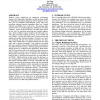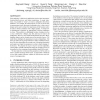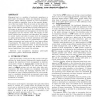943 search results - page 106 / 189 » How should data structures and algorithms be taught |
SIGMOD
2004
ACM
14 years 9 months ago
2004
ACM
Database system architectures are undergoing revolutionary changes. Most importantly, algorithms and data are being unified by integrating programming languages with the database ...
ICS
2010
Tsinghua U.
14 years 2 months ago
2010
Tsinghua U.
The emergence of multicore processors has increased the need for simple parallel programming models usable by nonexperts. The ability to specify subparts of a bigger data structur...
PVLDB
2010
13 years 7 months ago
2010
Data ambiguity is inherent in applications such as data integration, location-based services, and sensor monitoring. In many situations, it is possible to “clean”, or remove, ...
IFM
2010
Springer
13 years 7 months ago
2010
Springer
Safe is a first-order eager functional language with facilities for programmer controlled destruction and copying of data structures. It provides also regions, i.e. disjoint parts...
CIKM
2001
Springer
14 years 1 months ago
2001
Springer
Managing trust is a problem of particular importance in peer-to-peer environments where one frequently encounters unknown agents. Existing methods for trust management, that are b...



